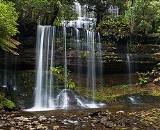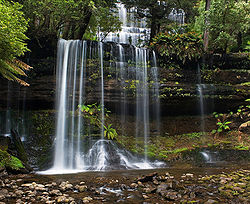
Russell Falls
Encyclopedia

Mount Field National Park
Mount Field National Park is a national park in Tasmania, Australia, 64 km northwest of Hobart. The landscape ranges from eucalyptus temperate rainforest to alpine moorland, rising to 1,434 metres at the summit of Mount Field West....
, in Tasmania
Tasmania
Tasmania is an Australian island and state. It is south of the continent, separated by Bass Strait. The state includes the island of Tasmania—the 26th largest island in the world—and the surrounding islands. The state has a population of 507,626 , of whom almost half reside in the greater Hobart...
, Australia
Australia
Australia , officially the Commonwealth of Australia, is a country in the Southern Hemisphere comprising the mainland of the Australian continent, the island of Tasmania, and numerous smaller islands in the Indian and Pacific Oceans. It is the world's sixth-largest country by total area...
. Accessible by a paved walking track, the falls are a popular tourist attraction.
They were first named the Browning Falls after the original discoverer, c.1856, but were known as the Russell Falls after 1884, by which time they were already a popular tourist attraction. The Falls Reserve was established to protect them in 1885. In 1899 the Russell Falls were selected as one of eight images to be used on a set of pictorial postage stamps, aimed at promoting the then colony's growing tourist industry.
Russell Falls are located 100 metres downstream of Horseshoe Falls
Horseshoe Falls (Tasmania)
Horseshoe Falls are located upstream of Russell Falls at Mount Field National Park, in Tasmania, Australia. The falls are a popular tourist attraction.Horseshoe Falls are composed of horizontal marine Permian siltstone benches, as are Russell Falls....
.
The horizontal rock strata over which the falls flow are Permian
Permian
The PermianThe term "Permian" was introduced into geology in 1841 by Sir Sir R. I. Murchison, president of the Geological Society of London, who identified typical strata in extensive Russian explorations undertaken with Edouard de Verneuil; Murchison asserted in 1841 that he named his "Permian...
siltstone
Siltstone
Siltstone is a sedimentary rock which has a grain size in the silt range, finer than sandstone and coarser than claystones.- Description :As its name implies, it is primarily composed of silt sized particles, defined as grains 1/16 - 1/256 mm or 4 to 8 on the Krumbein phi scale...
, and their more-resistant vertical faces consist of sandstone
Sandstone
Sandstone is a sedimentary rock composed mainly of sand-sized minerals or rock grains.Most sandstone is composed of quartz and/or feldspar because these are the most common minerals in the Earth's crust. Like sand, sandstone may be any colour, but the most common colours are tan, brown, yellow,...
. The surrounding plant life includes swamp gum
Eucalyptus regnans
Eucalyptus regnans, known variously by the common names Mountain Ash, Victorian Ash, Swamp Gum, Tasmanian Oak or Stringy Gum, is a species of Eucalyptus native to southeastern Australia, in Tasmania and Victoria...
and sassafras.

